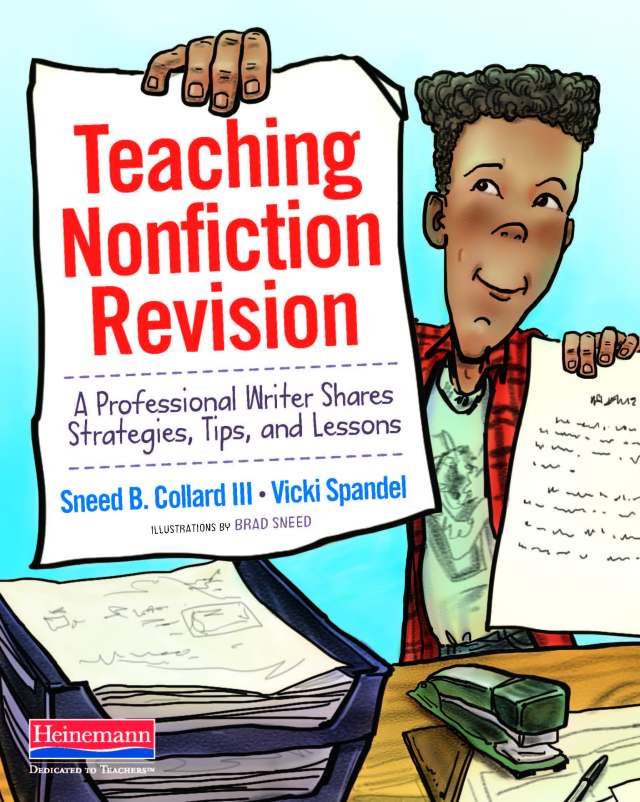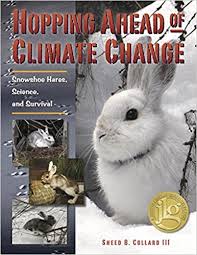
Teaching Nonfiction Revision: A Professional Writer Shares Strategies, Tips, and Lessons, by Sneed B. Collard III and Vicki Spandel. 2017. Portsmouth, NH: Heinemann. 223 pages.
Available for pre-order/order:
http://www.heinemann.com/products/e08777.aspx
Genre: Student and Teacher Resource
Levels: 4th-8th grade (Though that’s the target grade levels, this book’s ideas, concepts, and tips are easily adaptable for K-12 and beyond.)
Features: Table of contents (Big deal, right? Every book like this has one. Wrong! This one reads like a lesson planning guide for your classroom! Much more on this later.), Lessons, strategies, and examples from both student writers and from Sneed’s own nonfiction books, Recurring pop-up sections—In Conference, A Note to the Teacher, A Writing Secret to Share with Students, Something to Try—filled with practice exercises and advice directly from Vicki Spandel, Appendix A: Checklist of Revision Possibilities for Nonfiction Writers, Appendix B: Recommended Nonfiction Books for Students, Appendix C: Recommended Nonfiction Books for Adults, References, and Online resources specific to this book available for download from www.heinemann.com
Introduction
With a name like Sneed B. Collard III, he better be good, right? Absolutely right! A book about nonfiction revision from such a skilled, experienced writer of nonfiction? I’ve been reading and recommending his books for over twenty years. So, sign me up! But wait (and at the risk of sounding like a late night infomercial)—there’s more, so much more. With Teaching Nonfiction Revision, you get all of Sneed’s nonfiction-writer-wisdom, the real inside scoop on his process as a writer, AND the added bonus of writing guru-teacher whisperer Vicki Spandel’s classroom insight popping up at just the right moments, practically answering your questions before you can even ask them. I’ve known Vicki Spandel, and had the pleasure to work with her, for close to thirty years. So, it’s a done deal–double-sign me up!
Just in case, before I launch into a few of the highlights Teaching Nonfiction Revision has to offer, you’re already pumped up and ready to buy, I’ll repeat the pre-order/order information:
http://www.heinemann.com/products/e08777.aspx
(Now I do sound like an infomercial.)
One of my favorite things about this book is that Mr. Collard never tries to sugarcoat the truth about the act of revision: Revision is not always easy or fast. And, as you may already have experienced, revision, for many student writers, is a total mystery. He addresses the struggle students have with revision, using a sample of student writing, in the book’s introduction–when the page numbers are still Roman numerals! “Not knowing what else to do, students plug in extra facts, make sentences longer, fix spelling, change fonts, swap one word for another—or maybe insert an adjective, adverb, or exclamation mark for emphasis.” (xiv) I’m sure that “revision” of this type is something you’ve experienced in your own classroom. I’ve had middle school students take an even more direct route by simply printing two copies of their writing, labeling one “Rough” and the other “Final.” Boom! Done! The purpose behind this book is to remove this cloud of mystery, not with any magic words or spells but with “…nuts-and-bolts teaching strategies design to strengthen students’ nonfiction revision skills.” (xv) There are no promises of instant success, but these strategies offer a “Big” to “Small” path to understanding and application. “Students may not master every strategy on the first try, but they will make huge strides toward understanding the revision process. Given practice, they will write words you will actually look forward to reading.” (xv)
The passion both Sneed and Vicki have for their craft and for sharing it with teachers and students is the energy blowing away any clouds of mystery or misunderstanding about revision. Their voices are distinct and comforting—they write from and about real experiences. And that’s one of my other favorite things about Teaching Nonfiction Revision (there are many). The authors make it clear that a fuller understanding of the process of revision supported by the toolbox full of strategies this book provides, opens the door to happy, even joyful times for student writers and their teachers. Sneed lets readers in on his secret—revision is not only important work, it’s downright fun! Let me now share with you a few of my other favorite parts and features of Sneed and Vicki’s new book.
Table of Contents (Seriously)
I’m retired, so I am no longer an every day teacher with my own students. The classroom still calls to me, so I get my fix by substitute teaching and volunteering–exclusively at my neighborhood elementary and middle school, with teachers I know and with advance notice. Going back to the same classrooms means I get to know the students, even if I’m only in front of them now and then. You might think that I walk in empty handed and simply follow the regular teacher’s plans, but I can’t help myself. I bring in books, student writing samples, and ready-to-go, focused writing activities—just in case. I want the teachers to leave me plans, but I always ask if it’s OK if I slip in an activity involving writing, especially if it would support something currently happening in the classroom. And they always say, “Yes!”
When I first picked up Teaching Nonfiction Revision, my plan was to give it a quick read to get a feel for Sneed and Vicki’s message. My plans changed as soon as I read the Introduction (something I like to do first) then took a look at the Table of Contents. The book is divided into seven parts: I: Setting the Stage, II: Big-Picture Revision, III: Scene Revision, IV: Paragraph Revision, V: Sentence Revision, VI: Word Revision, VII: The Final Wrap. I immediately grabbed a pad, pen and highlighter, and slipped into teacher-mode. Not substitute teacher mode but every-day-teacher mindset! I mentally superimposed a school calendar over the seven parts and the breakdown of topics in each section and began planning. I couldn’t help myself. It was as if the authors had asked me personally about my teaching experiences—what my students might come in believing about writing and revision, what I knew students needed, what questions I would ask, my personal struggles as a writing teacher, where and when I might say, “What about…?” Here’s one example of what got me excited—the subheadings from Part II: Big-Picture Revision:
- Isolate Your Main Idea
- Research Your Topic—Again!
- Add Missing Information
- Cut, Cut, Cut!
- Check Your Organization
- Unleash Your Voice!
- End With Something to Say
- Give It a Rest
I sadly reminded myself, “Hey! You don’t have a classroom!” so I switched mental gears. As a substitute, I have been in classrooms where, at various times, students needed help with each of these items. I couldn’t wait to mine these sections for their golden strategies to turn into booster-shot lessons to carry with me into any classroom. My temptation was to skip ahead to various sections, but I resisted. It’s something you could easily do, but I recommend a complete front to back read. This way you’ll get a feel for the overall process of revision and an appreciation for the beauty behind organizing the book’s strategies from “big” to “small.” As the authors say, “Whether you are a regular classroom teacher, a literacy specialist, or a writer yourself, this is your book, and we know you’ll figure out the best way to use it.” (xv)
Appendices and References—Take a Look Before You Read
Teaching Nonfiction Revision, as you will see, has three appendices—A, B, and C. Appendix A—“Checklist of Revision Possibilities for Nonfiction Writers”—is a starter list of revision reminders, “…things you might do when revising.” (207) I appreciate that it’s a list, not a formula or set of boxes to be ticked off in order. As you and your students do more nonfiction writing and revising, the authors encourage you to “…add your own ideas to ours.” (207) I do suggest you read the checklist before you dive into the book. Not only will it activate and alert your subconscious to what’s coming, it will give you the opportunity to reflect on your own revision practices, “Hey! I do that, too!” Very comforting!
Appendices B-“Nonfiction Books for Students”—and C—“Nonfiction Books for Adults”—are loaded with book recommendations for you and students of all grade levels. (Books by a certain Sneed B. Collard, III, are included and highly recommended!) Again, by taking a pre-reading look at the titles, you may find some that already know and love. Again, rather comforting!
The “References” section, is included for your additional comfort. Here is proof that Sneed and Vicki have mined not only their own work and experiences, they’ve tapped into the writing of other experts as well.
Online Resources—Just Look for the Icon
Anytime you see the icon in the margin, you will know that there is an online resource available to help you bring a specific lesson or activity into your classroom. All you have to do is follow the directions at the end of the Table of Contents to create an account at Heinemann.com and register your book (once you’ve purchased it). This access will allow you to duplicate or project writing activities for your students. Very handy!

Trait-Based Writing and Revision
The Six Traits of Writing and trait-based writing instruction is the well from which my career as a writing teacher, presenter, and co-author was drawn. The language of the traits—ideas, organization, voice, word choice, sentence fluency, and conventions—in my mind, is the vocabulary of writers. It connects and integrates varied approaches to writing instruction and writing as a process. The language provides a specific feedback loop for readers and writers, students, teachers, and parents to communicate about what they value in writing. And it is the language embedded in the act of revision.
Teaching Nonfiction Revision is not a book focusing on the traits exclusively. But if you’re a teacher who has “grown up,” so to speak, on trait-based writing instruction (Vicki Spandel’s Creating Writers, Creating Young Writers, Write Traits Classroom Kits, Sixtraitgurus) you need to know, even if the traits are not called out, they’re all here (even Conventions) playing lead roles in the “big” to “small” revision strategies. And if you are not an experienced “Trait-er,” have no fear. This book is still for you. No secret handshakes required.
Sneed—Modeling Revision (and Struggling) Through His Own Writing
If by chance you are not familiar with any of Sneed’s body of published works (80 + titles), Teaching Nonfiction Revision will not only introduce you to many of them, it will give you (and your students) a backstage pass to his writing and revision processes. Sneed uses his own writing—actual examples of drafts to model and introduce revision strategies he uses to hone his work. In the “Unleash Your Voice!” section of Part II, Sneed points out that, “…writers have to learn to recognize what kind of voice matches their subject and intent for a passage. Do they want to be funny? Dramatic? Conversational? Precise? Persuasive?” (51) This is such an important element of helping nurture voice in student writers—aligning voice with purpose and audience. He references a particular moment in his book, Hopping Ahead of Climate of Climate Change: Snowshoe Hares, Science, and Survival (2016) where he struggled with this decision. In a passage at the beginning of the book, he describes an owl and hare, hunter vs. the hunted, in the ultimate predator/prey moment. Sneed lets us know what he was thinking, “I had to ask myself, ‘How do I write about this?’” (52) He shows readers two of the many options he considered, including his final choice, each with a very different voice. What was the deciding factor? Purpose! His decision wasn’t based on word count or whatever idea first popped into his head. He needed to stay true to his “subject and intent.” What a great lesson and discussion for student writers!

Later in the book, when the “big” to “small” revision lens has zoomed in on paragraphs in Part IV, Sneed returns to the owl and hare passage in Hopping Ahead of Climate Change, to share another revision struggle (no sugar coating) he faced. “To wrap up the passage, I wanted a sentence that emphasized how ominous this situation is for the species—but without getting hysterical about it.” (170) He shows readers six of the “twenty-plus variations” he tried, before revealing and reflecting on his final choice. (He tried at least twenty different variations of the same wrap-up sentence! 20!) “You’ll notice that to reach my goal, I tried myriad ideas and phrasing…Did I arrive at the best solution? I may never know for sure, but I do know that the struggle of trying brought me closer to what I wanted.” (171) This is a powerful message to students and teachers: Writing and revising is not easy or fast, but delivering your message (“subject and intent”) to readers is important and worthy of your best effort.
Vicki—Pep Talks, Tips, and Ideas for the Classroom
Dovetailing perfectly with Sneed’s strategies, Vicki’s appearances in Teaching Nonfiction Revision come in the form of four rotating pop-ins: Something to Try, A Note to the Teacher, In Conference, and A Writing Secret to Share With Students. Her presence is like an omniscient advice columnist who responds to your letters before you write them.
Dear Vicki—Bam! Here’s that book title you were going to ask for.
Dear Vick—Wham! Sentence fragments, right? Try this the next time you conference with her.
Dear Vi—Kabam! I’ve got your back—the perfect mini-lesson to kick-start your writer’s workshop.
When Sneed is wrangling with finding the appropriate voice (owl and hare example mentioned above), Vicki appears with a Something to Try called “De-Voicing a Passage.” She offers a short passage from Sneed’s book Pocket Babies and other Amazing Marsupials, for students to rewrite, without changing the passage’s meaning but “…bleeding as much voice out of it as possible.” (52) Discussing and listing the changes students made helps them gain a deeper understanding of what contributes to voice. (And asking students to write without voice is flat out fun!) If they know what to remove to suck the life out of a piece of writing, they’ll get better at knowing what to put in to breathe life into their writing.
What Vicki suggests with each aptly named Something to Try, A Note to the Teacher, In Conference, and A Writing Secret to Share With Students, are a combination of small, focused activities and practices that might be introduced as a mini-lesson or become an every-time-I-revise tool in your student writers’ toolboxes, alongside timely suggestions to gently guide you and your student revisers.
Final Comments
Sneed and Vicki open Part VII: “The Final Wrap,” with a reminder to readers, “…we have never intended this book to be a rigid regimen to be pursued with Navy SEAL-like determination…Sure, you may wish to incorporate every one of our strategies into your classroom, but…it’s more likely that you will pick and choose those you find most helpful.” (201-202) That’s my suggestion as well. I’ve only scratched the surface of what this book has to offer. It’s not a long book, but there’s a lot to pick and choose from to help you and your students become more confident writers and revisers. With Sneed and Vicki’s help, the act of revision loses its veil of mystery, and “With your encouragement and guidance, many students will discover the joy of turning their first rough ideas into something readers cannot put down.” (206) Imagine that! And with Sneed and Vicki’s encouragement and guidance you might discover (or rediscover) the joy of Teaching Nonfiction Revision.
As always, you can find Vicki here at www.sixtraitgurus.wordpress.com
For more about Sneed and his books: www.sneedbcollardiii.com
Coming up on Gurus…
I’m not exactly sure what Vicki is working on next. Perhaps something to kick off the new school year? (Yes, in case you haven’t noticed the back-to-school ads—which started in June, a new school year is just around the corner.) Actually, I think reading Teaching Nonfiction Revision, would be an excellent way to rev your teacher-engines. As always, thanks for visiting. And come back soon! Give every child a voice.



